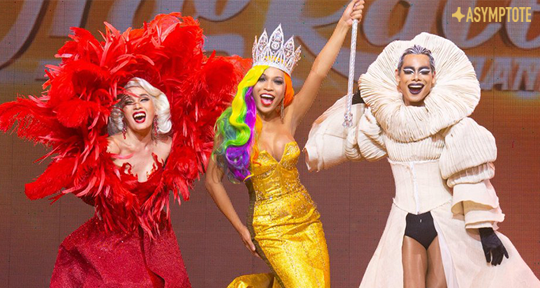In the twelve years since RuPaul’s Drag Race first premiered on the relatively unknown LGBTQIA+ cable channel Logo TV, the Emmy award-winning series has gained an immense global following and become one of the defining shows of our age. The reality TV show, which boasts thirteen seasons (along with six All Stars series), follows drag queens competing in a range of performance-based challenges to be crowned “America’s Next Drag Superstar.” More recently, the race has expanded overseas, with Spain becoming the latest in a series of international spinoffs, joining Thailand, the UK, Canada, Holland, and Australia/New Zealand. In its evolution from a niche talent show for US drag performers to a global cultural phenomenon, Drag Race has propelled a queer subculture from the margins to the mainstream and put drag performance in the international spotlight. In the journey to globalize the show, translation has played a key role in giving drag and LGBTQIA+ culture visibility around the world.
It is of course thanks to the subtitling and dubbing of Drag Race into multiple languages that the US original achieved global success and found audiences worldwide. For translators, capturing the nuances of the show is no small feat. Much of its entertainment relies on verbal and cultural humour, each episode packed with English-based puns, double-entendres, and innuendos that can be hard to translate. Similarly, the dialogue showcases slang terms, neologisms, and catchphrases that are deeply rooted in the drag and LGBTQIA+ culture of the US. Take “mothertuckin’,” for example. In drag culture, tucking, used here to rhyme with a certain English swearword, refers to a taping practice used by drag queens to make their genital anatomy appear more feminine. Recreating this kind of wordplay poses a challenge for translators working in a context with a less developed drag culture and associated vocabulary.
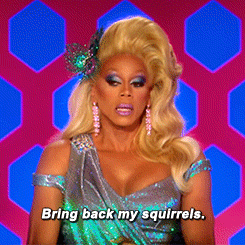
Some expressions are easier to adapt. The iconic catchphrases RuPaul uses each week to either invite a queen to stay in the competition or send them packing—“shantay, you stay” and “sashay away”—transition seamlessly into Spanish in Drag Race España: shantay, te quedas and sashay, te vas. Just as RuPaul “condragulates” contestants on challenge wins, the host of the Spanish series, Supremme, uses the neologism felicidrages instead of the usual felicidades (congratulations). Viewers of the international shows will notice that contestants often use, in English, some of the most popular expressions from the US series, such as “to throw shade” (to criticize/insult), “sickening” (fabulous), and “no tea, no shade” (no disrespect). That these so-called RuPaul-isms and US drag terminologies have seeped their way into other languages demonstrates how much the US show has influenced the lexicon of drag cultures the world over.
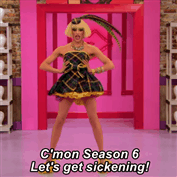
Yet the non-Anglophone versions of Drag Race also reveal how drag and LGBTQIA+ cultures have evolved differently in other countries, each with its own references, codes, and nuances. These localized vocabularies create new challenges for translators, as a recent Twitter thread on Drag Race España pointed out.
The post, shared by a viewer, contained screenshots of the Spanish series’ first episode, in which the translator’s annotations had been left in the English-language subtitles in error (and swiftly removed, as the author of the tweet notes). For me, a researcher in audiovisual translation (as well as a fan of the show), this was a rare and exciting glimpse into the creative practice of those whose work is largely condemned to invisibility, and highlighted perfectly the complexities of translating a show like Drag Race.
The best part of Drag Race España is the notes from the English translator that they forgot to erase throughout pic.twitter.com/6pBh5YRzQ7
— Adam Feldman (@FeldmanAdam) June 3, 2021
We see the subtitler’s thought process as they grapple with jokes and wordplay, and how cultural references leave them caught between local and global pulls.
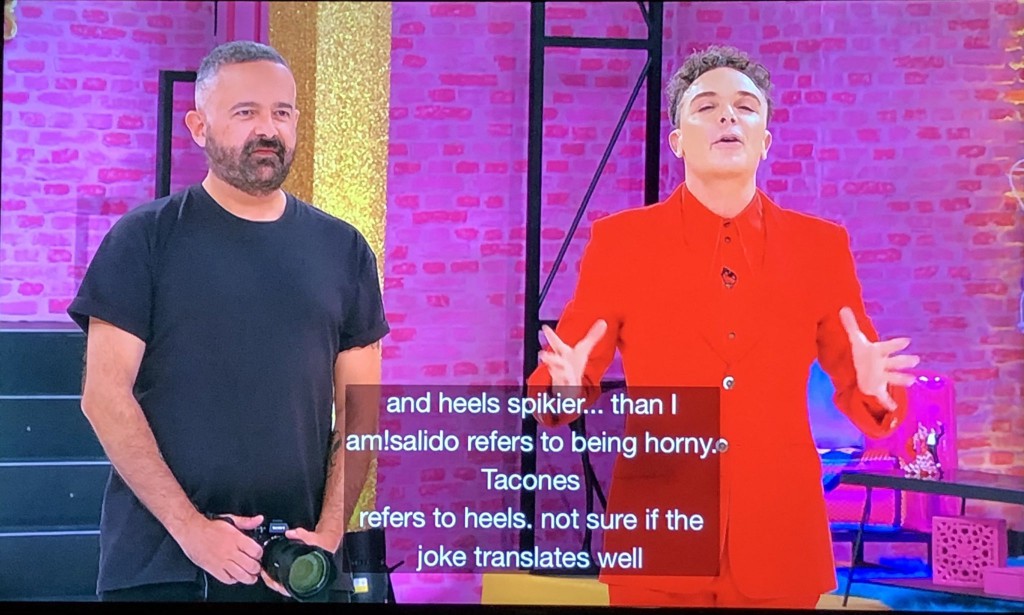
They consider swapping the names of lesser-known Spanish celebrities such as Carmen Sevilla and Lola Flores for those more familiar to a US public, like Carmen Electra and Janet Jackson.
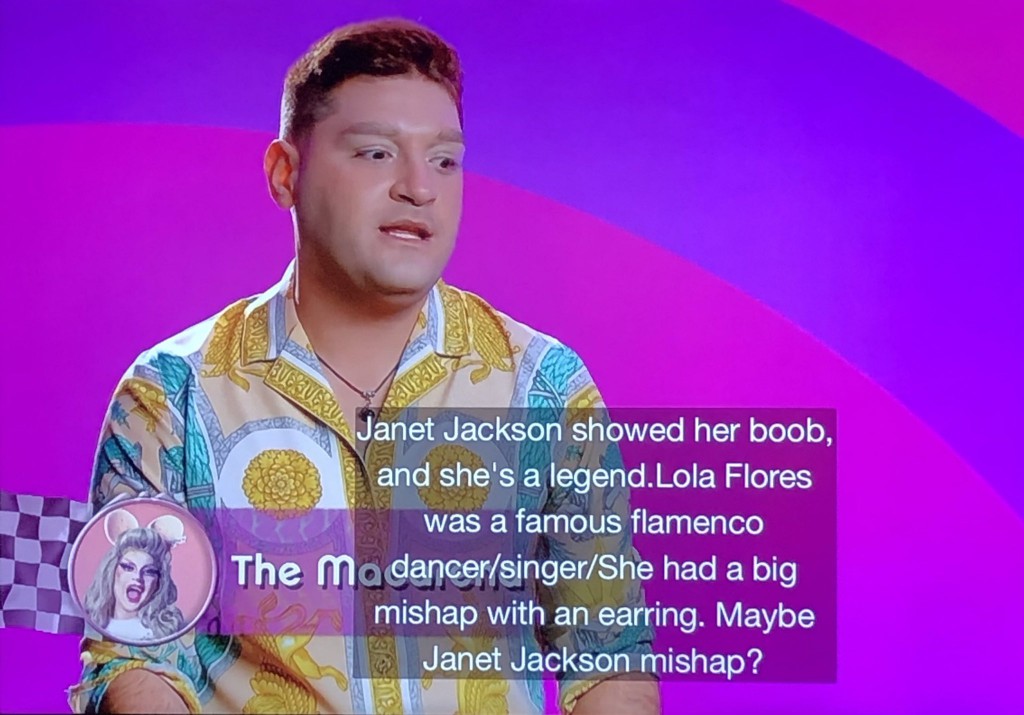
Relegating local references to obscurity in this way may seem to reinforce the American-centrism of Drag Race and the monopoly the US show appears to have on representations of drag performance in the global media. Yet the art and entertainment potential of drag itself relies heavily on the parody of pop culture, current events, and celebrities; American culture largely enjoys worldwide exposure and recognition, Spanish culture arguably less so. Substituting cultural references ensures that the jokes will land—and entertain the audience. And contrary to what the screenshots suggest, it is rarely possible to add extra information or explain unfamiliar terms. Subtitles typically have to be neatly pruned and tucked so you can barely see the stitches—not least due to time and space constraints, as well as the pervasive belief that the best subtitles are those that do not draw attention.
Indeed, it is most often when subtitlers make mistakes that their work is noticed, as the translation of culturally sensitive language in Drag Race España brought to bear. The decision to translate the Spanish term maricón as “f*ggot” in English left many viewers stunned. They took to social media to criticize the inclusion of homophobic slurs in the translated text.
Native speakers of Spanish explained that unlike its English-language equivalent, maricón has been positively appropriated and transformed from an insult into a term of empowerment and endearment by the Spanish LGBTQIA+ community. While the translation is literal and not necessarily linguistically inaccurate, viewers suggested that alternative terms with similar histories of reclamation within the Anglophone LGBTQIA+ sphere, such as “bitch” and “queer,” may have been more culturally appropriate.
And it is not only the subtitles of Drag Race España that have left audiences less than gagged. Drag Race fans across the globe have been pointing out translation mishaps for years—the industry must take note. Beyond the fierce runway looks, the gag-worthy drama, and the sickening lip-sync-for-your-life performances, Drag Race has proven itself an essential platform for educating fans on LGBTQIA+ history and raising awareness of the prejudice and oppression facing queer and traditionally marginalised communities. Although not without its flaws, Drag Race has a clear aim to promote diversity, equality, and inclusion. So too should the show’s translations.
Drag Race is an important show with impacts on different cultural, social, and even political levels—the same can be argued of its translation. Just like the show, the translation of Drag Race has been central in promoting, performing, and shaping queer identity, culture, and LGBTQIA+ visibility. As the responses from fans show, translation doesn’t simply allow cultural products, images, and ideas to circulate. It also influences the emotional responses toward, connections to, and understandings of those ideas. Translation not only provides access to foreign languages and cultures, but indeed shapes them, and shapes local cultures and languages as well.
It is in part through the translation of LGBTQIA+ media such as Drag Race that queer people across the globe are able to build a shared sense of identity, community, and solidarity in the face of continued struggle and adversity. Translation of the show has both exposed and bridged geographical, cultural, and linguistic differences between drag and LGBTQIA+ communities, sparking important discussions about representation and diversity. With an Italian version of Drag Race soon to hit screens, attention will once again be drawn to the differences of localized drag styles and traditions—differences that will need unpacking (or untucking) in translation. Translators, start your engines . . .
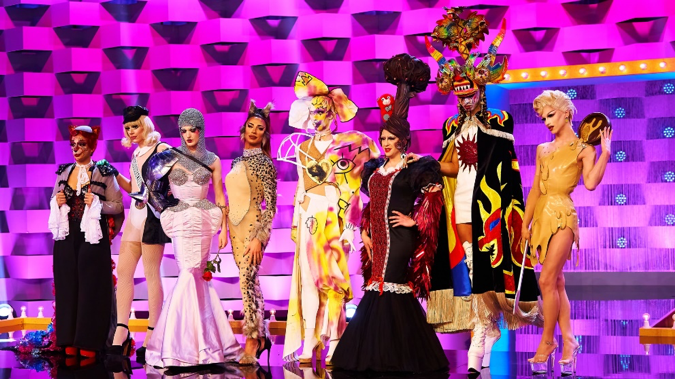
Francesca Leveridge is a doctoral researcher in translation studies at the University of Nottingham, UK, funded by the AHRC Midlands4Cities Doctoral Training Partnership. Her research investigates the portrayal of identities in subtitled audiovisual products, focusing on the translation of language diversity and linguistic varieties.
*****
Explore audiovisual translation on the Asymptote blog:

